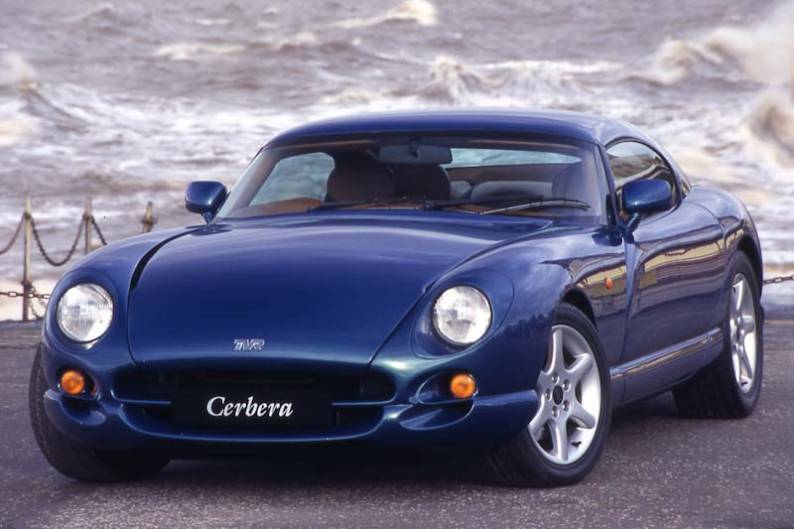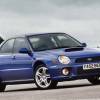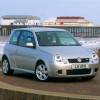
RAC sale – up to 33% off*
• Roadside cover from £5.29 a month†
• We get to most breakdowns in 60 mins or less
• Our patrols fix 4/5 breakdowns on the spot

BY ANDY ENRIGHT
Introduction
The Cerbera, more than any other TVR before it, cemented the Blackpool company's place in the big league of performance car manufacturers. Here was a proper 2+2 sports coupe with crushing power, sleek good looks and an affordable price tag. What's more, it also offered a range of engines developed entirely in-house. Few believed that TVR had either the technical acumen or financial muscle to manage this, but with three different TVR-designed engines now residing under the elegant bonnets of the Cerbera range, some quite considerable amounts of humble pie have been eaten. One issue that has dogged the Cerbera has been reliability. Some high-profile cars have spectacularly failed, so what can the general public expect from a used model? Find out here.
Models
Models Covered:
(2 dr coupe 4.0, 4.2, 4.5 petrol)
History
The Cerbera was first displayed at the 1993 London Motor Show. Named after Cerberus, the mythical three-headed dog guarding the gates of Hades, the show car was anything but a hellish dog's dinner. Based on a lengthened Chimaera platform, the Cerbera stunned all who saw it. With its wild interior and long doors with no handles to break up the curvaceous lines, advance orders were taken from day one. It wasn't until the start of 1996 that the first customer cars were delivered. Powered by the TVR AJP8 4.2-litre V8 engine, the Cerbera 4.2 hit the covers of every motoring magazine in the country with its incredible performance figures. Unfortunately the press demonstrators suffered some problems, one locking its occupants in, another's rear window being sucked out and a third having its timing chain disintegrate.
Whilst working to fix many of the problems that owners were experiencing, TVR announced the Cerbera 4.5 in 1997. With even more power than the 4.2-litre car (420 vs 360bhp) it was more muscular in the upper reaches of the rev band but slightly less responsive lower down, to the disappointment of some.
January 1999 saw the launch of the Cerbera Speed Six, using a four-litre straight-six cylinder engine, again of TVR's own design. A remarkably lightweight and compact unit, the Speed Six developed 350bhp and even more torque than the 4.2-litre V8. The Speed Six is now the most popular engine choice in the entire TVR range, although most used Cerberas will be fitted with the 4.2-litre V8.
What You Get
What's it like to live with a Cerbera? Well, it's certainly never dull. The interior, with its underslung instruments and wild swooping dashboard never fails to delight, and gives rise to certain Cerbera rituals. Pressing the red button under the steering wheel cuts the ignition. The engine stops instantly, like a racing car. That steering wheel holds push button controls for lights, washers wipers and horn. Once you've worked out which switch does what, it's surprisingly intuitive.
The back seats are best reserved as additional luggage space, unless you plan to make a habit of transporting people who have no heads or legs. There is however, a surprisingly generous amount of stowage space around the fascia. Before you take a test drive in the Cerbera, it'll boost your credibility enormously if you know the procedure for getting out of one. There's no internal door handle, you see. The Griffith used a little lever on the transmission tunnel and the Chimaera had a rotating aluminium pastille next to the gearlever, but the Cerbera has something different. On the door's side pocket is a tiny button which you'll need to press to make the door spring open.
Likewise to get in you must deactivate the alarm and press a button on the underside of the door mirror. To start the Cerbera press a black button below the fuel gauge. Hold it in, wait for the electronic diagnostics to do their stuff and then listen to the engine spring into life. Both the AJP8 engines and the Speed Six respond to the throttle in an alarmingly direct way. It feels as if the car's engine is hardwired to your foot. There's no flab or mush in the throttle pedal. Press it and the revs rise, take your foot off and they die back. Instantly. People buy Cerberas for the soundtrack and the car doesn't disappoint. It's a magnificently hard-edged sound, quite different to the burbling Rover V8 cars of the past, but equally evocative.
What You Pay
Please fill in the form here for an exact up-to-date information.
What to Look For
"I have amassed 2000 miles on dealer visits alone". "Thank God for the warranty is all I can say"."It has let me down on every trip over 100 miles". "Interior finish is frightening". There's no gentle way to break the news to you. The TVR Cerbera is a spectacularly unreliable car. These quotes from owners are indicative of the many things that can and do go wrong with Cerberas. When asked what they would like to see improved on the car, owners wanted better ventilation, rear suspension that was less jittery, a handbrake that worked, brighter air conditioning LEDs, less wind noise, a better stereo, intermittent windscreen wipers, fewer electrical problems with doors and security, a clutch footrest, non vibrating rear view mirrors, better rear ground clearance and less brake squeal. The key grouse was about the one-year warranty and many owners found the dealers unhelpful. The most pertinent quote came from one frustrated owner who when asked what he most wanted in his Cerbera replied, "A spare car in the boot."
Common faults include misaligned gearchange linkages, warped rear suspension wishbones, snapped steering-wheel control ribbon cables, deteriorating rear anti-roll bar mounts, leaking radiator cores, seizing door hinges, ineffective crankshaft seals, and shearing clutch release arms. It'll also be worth checking the alternator, water pump and remote boot opening system. The security system comes in for constant flak, with the 'plipper' having a very poor range with anything other than tip-top batteries and there have been several stories of owners being locked into their immobilised Cerbera. Two warranties were available for the Cerbera from new, 5 Star and 5 Star Gold. Look for used cars which had the superior 5 Star Gold warranty. TVR hate reports which stress the car's unreliability, but if they want us to eulogise over the car's styling and performance, they have to put up with the other side of the coin as well.
Replacement Parts
Trying to establish definitive parts prices for Cerberas is tricky, due in no small part to the fact that the vehicle has undergone a series of tiny ad-hoc improvements and changes throughout its lifetime. Without a quotable chassis number many parts prices will fluctuate hugely. Check your local dealer for details.
On the Road
Everything about the Cerbera is firm and purposeful. The power steering offers minimal assistance, the clutch is heavy and the gearchange requires a hefty shove. The power delivery of all Cerbera engines may come as a surprise if you'd been reading reports of the car's explosive performance. There's no peakiness, none of the drama of a turbocharged installation, just a massive wall of torque. The noise is a sharp bark rather than a rumble, and trying to catch the rapid rise and fall of the engine with the gearbox is an art that requires some practice.
It's only when you get the TVR up to speed through a series of bends that all the ingredients fall into place. The thick wheel rim feeds back all the road surface information you could ever need through those huge Bridgestone tyres, and the steering itself is so quick, you'll only need a gentle roll of the wrists to send the Cerbera's nose darting towards the next apex. Get a bit brave and you'll find the front-end grip more than a match for the back. The brakes are impressive four-pot AP-Racing callipers with ventilated discs, and have little trouble in retarding the lightweight TVR. Steering and stopping are no problem, but how much go does a Cerbera muster? Rest to sixty in 4.0 seconds and a top speed of 180mph from the 4.2-litre car should satisfy that compunction. The Speed Six figures are broadly comparable, but the added muscle of the 4.5-litre V8 lets it race up to 100mph in just 8.8 seconds. That's enough to make a Ferrari 550, Lamborghini Diablo VT or Porsche 911 GT3 appear somewhat tardy.
Overall
You need to be brave to drive one and even braver to sign on the dotted line for a used TVR Cerbera. Despite the car's numerous faults, it's still so much cheaper than anything else with an equivalent level of performance that perhaps this can be excused. They say that fortune favours the brave. Good luck.







